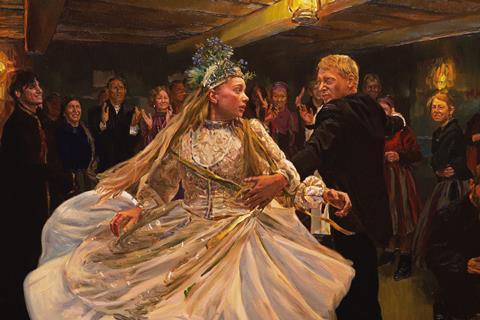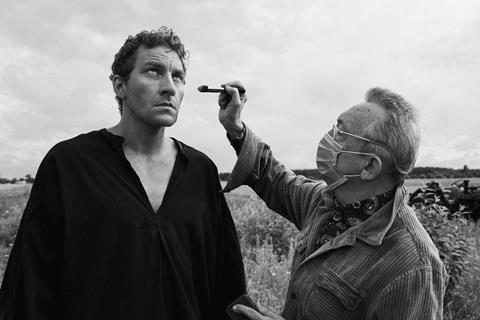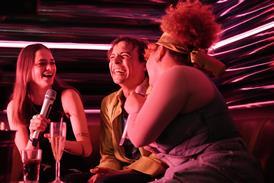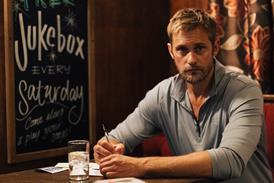For their follow-up to painted animation hit Loving Vincent, filmmaking duo Hugh and DK Welchman delved into Polish literary classic The Peasants. Screen talks to the creative team about bringing the Nobel Prize-winning rural saga to life.

Oil painting on The Peasants was 60% complete when, in the early hours of February 24, 2022, Russia launched its invasion of Ukraine. With the Polish feature animation having 25 Ukrainian artists on its team, producer Sean M Bobbitt leapt straight into action.
“Sean got in his car and kept going back and forth to the [Poland-Ukraine] border, picking up our painters who were coming over with rucksacks,” says Hugh Welchman, co-director of the film with his partner DK Welchman. “I’d pick them up, take them to Warsaw; they’d stay at my place for one night, get a shower,” says Bobbitt. “Then I’d take them to the train station, and they’d come up to stay in my apartment in Sopot [the northern Polish town where the trio’s BreakThru Productions is based].”
This can-do attitude defines the production journey of The Peasants, BreakThru’s second oil-painting feature after 2017’s Loving Vincent, which grossed more than $42m worldwide and was nominated for best animated feature at the 2018 Oscars and Bafta Film Awards. The Peasants is an adaptation of Wladyslaw Reymont’s novel of the same name, published in four parts between 1904 and 1909. The film focuses on Jagna Paczesiowna, a young peasant girl committed to marry the richest peasant in the village, when she is in love with his son.
Within a fortnight Bobbitt was finding his Ukrainian colleagues traumatised by the attacks on their country. “Any time a helicopter or airplane flew overhead, they’re in fear,” recalls the producer. “Because they know that it’s going to drop a bomb somewhere.” It was women painters only, with the men required to stay and fight for their country. The producers were grateful for their sole exception, Yaroslav Svirniak, “one of our top painters on Loving Vincent”, who was allowed to leave Ukraine because he has five children, according to Hugh.
The Ukrainian artists brought a timely boost to a cash-strapped Polish team. “Everyone was freaking out about inflation, which was running at nearly 20% in Poland,” says Hugh. “Then the Ukrainians come into our studio and they’re so positive. They just come with a rucksack and say, ‘We want to work!’ They brought such energy to our studio, they just put our other problems in perspective.”
Four months later, attacks on Ukraine capital Kyiv had subsided. “The male painters who remained [in Ukraine] said, ‘We need to provide for ourselves and our families. Can you please reopen the studio,’” recalls Bobbitt, who also produced Loving Vincent. Russia resumed critical infrastructure bombing within days of Kyiv’s Morefilm animation studio reopening, causing frequent electricity blackouts. Even that did not stop the artists. “Our painters would be reading by candlelight with jumpers on, waiting for the power to come back on so they could paint another frame,” says Hugh.
The Peasants overcame these challenges to complete post-production in summer 2023, just weeks before a world premiere at Toronto International Film Festival. Poland’s New Europe Film Sales has multiple deals in place already, with Sony Pictures Classics taking territories including the US where a December 8 release is set. Vertigo Releasing bought UK-Ireland rights and will release on the same date. The film is Poland’s entry to the international feature Oscar, and will compete in animation categories across awards season.
Classic text
Before Russia’s invasion of Ukraine or the pandemic, it was her reassessment of the Polish literary staple as an adult that drew in DK (aka Dorota Kobiela). “It’s required reading when you’re 16,” she says. “But it’s a love-hate relationship for Polish people. When you’re 16, and you have a 1,000-page novel that has 10 pages describing the changing seasons, you think, ‘Come on, get on with it!’”
DK listened to The Peasants as an audiobook in 2015, while making Loving Vincent. “It was just so vivid for me,” recalls the director of the moment she decided to attempt the project. “Reymont’s novels translate well to cinema because the emotions are very strong. There’s lots of passion, incredible characters, great drama.”
Securing the rights was not a hurdle, with the book in the public domain. The issue she and Hugh faced was cutting a 1,000-page novel down to a 100-page script. The duo broke the back of the writing over the summer of 2019, at their house in Gdynia, on Poland’s Baltic coast.
Although depicting a whole village, the novel has four key characters: patriarchal peasant Boryna, his son Antek, Antek’s wife Hanka, and Jagna. The Welchmans opted to centre the story on Jagna. “She’s the common ground of all the characters — the common element of the drama,” says DK. “I think she’s who Reymont wanted to express himself through. He was a sensitive guy coming from a traditional family.”
“The other characters are so defined by Reymont, whereas Jagna is a bit ethereal,” offers Hugh. “He doesn’t pin her down, so that was intriguing for us.” DK describes Jagna as “a blank canvas — you can write her more. Her biggest arc is when she realises she’s proud that she doesn’t belong. That’s what makes her special.”
Although the filmmakers had a finished script in 2019, Covid-enforced pauses gave them space to adjust what they had written in the following two years. “With animation, the idea is you have the script all worked out beforehand,” says Hugh. “It was different with this one — we sculpted it more as we went along.” The script was “15-20% longer than the final film”, says the director. “There are so many iconic sequences that are so memorable in the book, and you can’t include them all.”
One such moment was the death of a key character in the novel. “It was with heavy hearts that we gave that up, but it’s better for the film.”
Tried and tested

In a technique similar to that used on Loving Vincent, The Peasants shot first on camera with actors in costume on set, in the mode of a traditional live-action film. “For an adaptation, you’re already reading the novel with certain people in your head,” says DK of the casting process. For the role of Jagna, she wanted “someone who is extremely sensitive and very special”, and settled on Kamila Urzedowska, who had appeared in Polish crime series Zmijowisko. “That’s who she really is — it made it very easy for me.” They called on an old friend for Antek — Robert Gulaczyk, the face and voice of Vincent van Gogh in Loving Vincent. Love also blossomed on set — Gulaczyk is now in a relationship with Sonia Mietielica, who plays Antek’s wife Hanka. Miroslaw Baka took the role of Boryna.
After a 50-day shoot in late summer 2020 (see sidebar, page 24), attention turned to hand-painting 40,000 frames — typically utilising six paintings per second — which were expanded to projection requirements by combining the animation processes of inbetweening and duplication. Having tested it before Loving Vincent, the filmmakers eschewed the 24 frames of animation per-second that Bobbitt says studios are moving towards. “The beauty of painting animation is you have that stutter,” says the producer. “Twenty-four looks too smooth; it looks more like a filter.”
The look of the film is inspired by Young Poland, a modernist movement from the early 20th century that encompassed art and literature, including Reymont’s novel. “It was a time when people were going out into the countryside, painting villagers and peasants,” says Bobbitt, with the production drawing on works from Jozef Chelmonski and Julian Falat among others. “It was a very realistic style. It really fit.”
Only 10 of the artists from Loving Vincent came to work on The Peasants. “On Loving Vincent, the average frame took two-and-a-half hours to paint; this one was five hours,” says Hugh. “It was twice as difficult — not only twice as long, but a whole different level of difficulty. Most of our painters from Loving Vincent just gave up because it was too difficult.” This left the producers needing to find more than 90 new painters. With many people unsure about travelling or relocating during the pandemic, this posed an additional challenge for an onsite production.
“It’s not like computer animation, we couldn’t do anything remotely with people in their houses; we need people physically in the studios,” says Hugh. Adds Bobbitt: “It has to be a light-controlled environment; it has to be done on a special steel structure that we created to do this painting technique. It’s three metres tall, so most people couldn’t fit it in their house.” Having advertised online through art schools and social media, the production hired artists making their living by selling paintings and art renovators for museums — all of them trained oil painters. They hand-painted the frames from the filmed images, while using the Young Poland works and a ‘design painting’ for each scene as reference.
“This [design] painting was establishing the style — the brushstrokes, the colour palette,” says Bobbitt. For active scenes, including fights, painters would use completed frames from other artists as reference, “so a smooth animation comes out of it”.
Collaborative effort
The production ended up with four painting studios across Poland, Lithuania, Ukraine and Serbia. Each facility had at least one supervisor, passing up the chain electronically to head of painting animation Piotr Dominiak and also DK. “Essentially, DK approved every one of the 40,000 painted frames in the film,” says Bobbitt.
The collaboration required was a change of working practice for many of the painters. “They’re artists, so they’re normally used to being independent, working for themselves,” says DK. “Here they’re giving up their style, their personalities just to be cogs in this machine. But they wanted to be that, and to create something beautiful together. That was so moving.” Animators then worked on the paintings to ensure the film’s consistency, with DK still fine-tuning the style throughout the summer of this year. “We still had these corrections,” says the director. “I was still saying, ‘Don’t paint sharp edges — it needs to be soft.’”
“A good portion of the film, we did in the last three months — even though we had worked on it for two years,” notes Bobbitt of the animation process. It is also latterly that the collaborators found a physical unity. With Covid restrictions in place in Poland throughout 2022, it took until March of this year before the team could socialise together properly. “Because we set the team up under Covid, and they were all new people, we didn’t know any of them properly until this year,” explains Hugh. “We started to be able to go out — people would meet up, we would dance together,” says Bobbitt. “It’s something we hadn’t done for two years.”
The war-induced studio closure in Ukraine extended the production period, costing extra money. Bobbitt found a note in the conditions of the Polish Film Institute that allowed the film to apply for more than the maximum $1.45m (pln6m). “It said in exceptional circumstances you can get more than the maximum, and they agreed to it,” says the producer. This allowed the film to receive an extra $480,000 (pln2m). “A studio being closed down because of the war definitely counts as exceptional,” says DK.
The final budget came in at $7.5m (pln31m). The Polish National Foundation and National Centre for Culture were “the real angels” of financing, Bobbitt believes. “Every year of production they would give us additional money — whatever they had that they could. The director of the centre realises this is a story the world should hear about, and is promoting Polish painting, literature, music.”
Success for the film has already come at home, with The Peasants attracting more than 1 million admissions at Polish cinemas in its first four weeks since releasing in mid-October, the biggest for any Polish film so far this year.
In an awards race of exactly a century ago, Reymont superseded esteemed writers Thomas Hardy, George Bernard Shaw and Thomas Mann to win the 1924 Nobel Prize for literature. “We feel like that this year,” says Hugh wryly, noting The Peasants’ animated competition including UK stalwarts Aardman with Chicken Run: Dawn Of The Nugget, plus Hayao Miyazaki’s Studio Ghibli title The Boy And The Heron. “We’re definitely the outsiders, but we stand a chance.” For The Peasants, what’s one more obstacle? Ns
Action Plan: Creating the physical film shoot

“We had to make two films on one budget,” says producer Sean M Bobbitt of shooting The Peasants in live-action before transforming that footage to oil-painting animation.
A 50-day shoot took place in late summer 2020, with two group scenes requiring extras moved to 2021 due to rising Covid numbers. A Warsaw studio was home to most filming, with production combining partial set-builds with green screens that were then filled in digitally.
Production designer Elwira Pluta came up with a plan to reduce costs, using cardboard boxes attached by metal rods and covered with printed canvas. The canvases could be switched and the boxes moved, allowing one set to become another. The compostable sets were highly commended by the British Film Designers Guild Production Design awards for ecological innovation.
As well as 30 principal performers, the production employed extras for group scenes including one set in a church and another when Jagna is banished from the town. They also spent a day shooting extras in peasant costumes across the seasons, as reference material for the painters. A rain machine was brought into the studio to aid the actors during scenes featuring inclement weather, with the rain replaced by VFX before the footage was passed to painters.
The entire village was also constructed in 3D creation tool Unreal Engine, allowing actors using green screens to see their characters’ surroundings. “It gave them an easier time imagining where they are and how they should be feeling,” says Bobbitt.























No comments yet